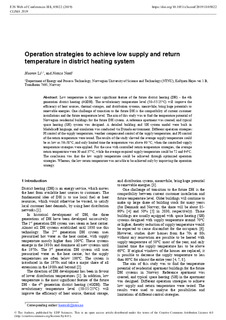| dc.contributor.author | Li, Haoran | |
| dc.contributor.author | Nord, Natasa | |
| dc.date.accessioned | 2019-08-26T08:54:53Z | |
| dc.date.available | 2019-08-26T08:54:53Z | |
| dc.date.created | 2019-08-23T11:02:52Z | |
| dc.date.issued | 2019 | |
| dc.identifier.citation | E3S Web of Conferences. 2019, 111 (050022) | nb_NO |
| dc.identifier.issn | 2267-1242 | |
| dc.identifier.uri | http://hdl.handle.net/11250/2610944 | |
| dc.description.abstract | English | nb_NO |
| dc.description.abstract | Low temperature is the most significant feature of the future district heating (DH) - the 4th generation district heating (4GDH). The revolutionary temperature level (50–55/25°C) will improve the efficiency of heat sources, thermal storages, and distribution systems, meanwhile, bring huge potentials to renewable energies. One challenge of transition to the future DH is the compatibility of current customer installations and the future temperature level. The aim of this study was to find the temperature potential of Norwegian residential buildings for the future DH system. A reference apartment was created, and typical space heating (SH) system was designed. A detailed building and SH system model were built in Modelica® language, and simulation was conducted via Dymola environment. Different operation strategies: PI control of the supply temperature, weather compensated control of the supply temperature, and PI control of the return temperature were tested. The results of the study showed the average supply temperature could be as low as 56~58°C, and only limited time the temperature was above 60 °C, when the controlled supply temperature strategies were applied. For the case with controlled return temperature strategies, the average return temperature were 30 and 37°C, while the average required supply temperature could be 72 and 94°C. The conclusion was that the low supply temperature could be achieved through optimized operation strategies. Whereas, the low return temperature was not able to be achieved only by improving the operation strategy. | nb_NO |
| dc.language.iso | eng | nb_NO |
| dc.publisher | EDP Sciences | nb_NO |
| dc.relation.uri | https://www.e3s-conferences.org/articles/e3sconf/pdf/2019/37/e3sconf_clima2019_05022.pdf | |
| dc.rights | Navngivelse 4.0 Internasjonal | * |
| dc.rights.uri | http://creativecommons.org/licenses/by/4.0/deed.no | * |
| dc.title | Operation strategies to achieve low supply and return temperature in district heating system | nb_NO |
| dc.type | Journal article | nb_NO |
| dc.type | Peer reviewed | nb_NO |
| dc.description.version | publishedVersion | nb_NO |
| dc.source.journal | E3S Web of Conferences | nb_NO |
| dc.identifier.doi | https://doi.org/10.1051/e3sconf/201911105022 | |
| dc.identifier.cristin | 1718226 | |
| dc.relation.project | Norges forskningsråd: 262707 | nb_NO |
| dc.description.localcode | © The Authors, published by EDP Sciences, 2019. This is an Open Access article distributed under the terms of the Creative Commons Attribution License 4.0, which permits unrestricted use, distribution, and reproduction in any medium, provided the original work is properly cited. | nb_NO |
| cristin.unitcode | 194,64,25,0 | |
| cristin.unitname | Institutt for energi- og prosessteknikk | |
| cristin.ispublished | true | |
| cristin.fulltext | original | |
| cristin.qualitycode | 1 | |

